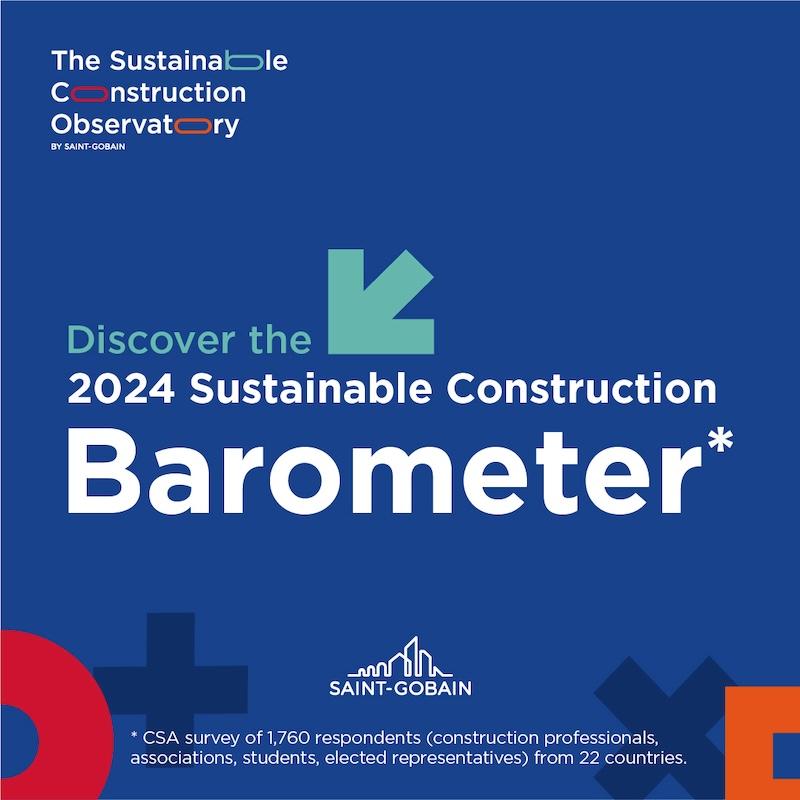Saint-Gobain Reveals Results of 2024 Sustainable Construction Barometer: An Overview of Sustainable Construction in the United States and Across the World
Published 04-25-24
Submitted by Saint-Gobain Corporation

Convinced of the urgency to advance the cause of sustainable construction in the face of climate challenges, demographic changes, and the need to protect resources, Saint-Gobain launched the Sustainable Construction Observatory in 2023. Today, this Observatory has released the second edition of its Sustainable Construction Barometer1, a study conducted by the CSA research institute, to better understand the perceptions of key stakeholders and the levers to be activated to accelerate the development of sustainable construction in the United States and around the world.
Benoit Bazin, Chief Executive Officer of Saint-Gobain: "The Sustainable Construction Barometer is intended to be a decision-making tool for all stakeholders in the sector, so that we can gain a better understanding of local sustainable construction issues and move from reflection to concrete action, in order to build a sustainable future for generations to come.”
Mark Rayfield, President & Chief Executive Officer of Saint-Gobain North America: "The 2024 Sustainable Construction Barometer is an important guide for every member of the building industry to better understand the perceptions and ideas key stakeholders hold toward sustainable construction. With 96% of US respondents believing the implementation of more sustainable construction is a high priority, we must all work together to continue moving the industry forward, and the data presented in the Barometer will help us do that.”
A broader survey to accelerate sustainable construction
Initiated last year in 10 countries, the Sustainable Construction Barometer is now based on a quantitative survey of professionals, students, elected representatives, and association members in 22 countries, including the United States. This provides a more detailed understanding of local and global issues, measures progress, and helps to identify areas of action to advance the crucial subject of sustainable construction as a strategic and essential response to major contemporary issues: climate change, resources constraints, and rapid urbanization accelerated by demographic pressure.
Four key findings emerge from this 2024 Barometer:
- Perceptions of sustainable construction remain stable, and the environmental viewpoint of respondents remains unchanged. The aspect of occupant well-being remains poorly recognized and valued.
- A shared sense of urgency exists among respondents, but there is a need for better awareness and cooperation.
- We must all work to ensure our stakeholders are better informed, better trained, and committed.
- Any implementation of sustainable construction will only be effective if it matches local realities.
Worldwide, 95% of respondents agree that the implementation of more sustainable construction is an important or priority issue.
This degree of urgency is clearly shared by all players, regardless of geographic region. At the same time, the understanding of sustainable construction often seems limited to environmental issues. Its definition is still largely associated with "green construction": directly linked to the energy efficiency of buildings (42%) and to achieving carbon neutrality in construction (33%). The notions of resilience and occupant comfort are considered more secondary. The only exception is Türkiye, where sustainable construction is perceived more in terms of the well-being of inhabitants, at 25% versus 14% for the global average.
Awareness of sustainable construction is high but varies depending on the respondent: While 87% of those questioned said they were familiar with sustainable construction, 20% of elected representatives surveyed said they had never heard of the concept.
Overall, awareness of sustainable construction worldwide is high: 87% of those questioned said they were familiar with sustainable construction, up +5 points from last year2. 68% of respondents claim to be sufficiently informed, but educational efforts are still needed, particularly among elected representatives. Most stakeholders in all countries (87%) agree that we need to go further in terms of sustainable construction, even if the aspiration for the status quo is growing (9%, +4 points compared to Barometer 20232).
Among the priority actions to be taken to accelerate the development of sustainable construction, raising public awareness is considered crucial, as is the issue of the perceived cost and competitiveness of materials, and the cooperation of all stakeholders. On the other hand, the role of public initiatives (standards, regulations, aid), although fundamental, remains underestimated. Lastly, energy renovation appears to be a priority in countries with a well-established building stock, compared to countries that prioritize new-build programs to house a growing population.
92% of construction professionals worldwide believe that sustainable construction will make up all or part of their business within the next 5 years.
Architects and engineering firms are at the top of the list of players most often cited for advancing sustainable construction. While building design professionals are credited with 29% of first-intention responses, elected representatives and public institutions follow close behind, with 21% and 20% respectively. Construction professionals feel strongly committed to sustainable construction: 85% say they carry out all or part of their business in this area, and 92% expect to do so within the next five years.
Lack of commitment to sustainable construction is perceived as a discriminating factor. Many professionals (62%, +3 points on 2023) consider their suppliers’ commitment to sustainable construction as a selection criterion. Among elected representatives, the sustainable dimension is a decisive criterion for awarding public contracts: nearly 9 out of 10 consider this criterion to be important.
Finally, among students who perceive the implementation of more sustainable constructions as a priority, 45% say they would not accept a job offer from a company that was not committed to sustainable construction.
And in the United States?
Sustainable construction in the United States is first and foremost a question of recycling materials and energy efficiency.
In the United States, 85% of respondents are familiar with the concept of sustainable construction (a slight decrease of 2% from 20233), with 50% stating they have a firm understanding. Sustainable construction continues to be defined by how buildings are constructed, and how materials are used and handled. 84% of US respondents most closely associated sustainable construction with the recycling of building materials, while 83% cited building energy efficiency, compared to 70% and 74% worldwide respectively.
North American construction professionals are motivated to move sustainable construction forward, with 79% prepared to take jobs that take sustainable construction into account, regardless of time, material supply or margins. However, more work must be done to educate elected officials and associations as they award contracts and work with construction companies.
Accelerating the pace: levers of action in the United States
US respondents see architects and building engineers as the most legitimate actors to advance sustainable construction in the United States (59% of respondents), aligned with worldwide perceptions (55%). These results constitute a major increase of over 20% from last year when only 34% of US respondents saw architects as major drivers). They are closely followed by private companies in the construction sector (47%). In addition, US respondents are more likely to see elected officials as major contributors to accelerating sustainable construction than their worldwide counterparts (47% compared to 32% worldwide).
For the second consecutive year, making sustainable materials, products, and solutions more competitive is seen as the top priority to advancing sustainable development by US respondents, with 39% citing the action as a major priority. At 37%, renovating existing buildings closely follows, and US stakeholders are much more likely to see this as a top priority compared to their worldwide counterparts (only 20% named it a top priority).
Beyond the Barometer, the work of the Sustainable Construction Observatory
The Sustainable Construction Barometer is just one component of Saint-Gobain’s Sustainable Construction Observatory, which includes Sustainable Construction Talks, international meetings bringing together all players in the sector together to discuss relevant issues, and Constructing a Sustainable Future, a digital magazine. The Observatory will continue to develop in 2024.
In 2023, three Sustainable Construction Talks were organized by the Observatory: the first, in Paris, dedicated to the subject of energy renovation in Europe; the second, during New York City Climate Week, devoted to the challenges of adapting to climate change; and a final in Dubai, during COP28, on the theme of sustainable construction in the Global South. Later this year, Saint-Gobain will again hold a talk at New York City Climate Week and during the International Greenbuild Conference in Philadelphia.
The Observatory's first findings:
- Financing and risk coverage: how can we facilitate investment in sustainable construction and energy renovation, and strengthen the role of the insurance system in adapting to climate change?
- Adaptation and resilience: sustainable construction is still largely viewed in terms of climate change mitigation. But the issue of transition in the sector also involves adaptation and resilience. How can we ensure that adaptation and resilience are better considered, in a context where sustainable construction is still often considered in terms of climate change mitigation?
- Inclusion and accessibility: how can we remove social and economic barriers to sustainable construction and energy renovation?
- Human resources and skills: how can we accelerate knowledge sharing and skills development in the field of sustainable construction?
- Global and local: how can we combine international alignment with local specificities?
The Sustainable Construction Observatory will continue its reflections on these topics and more in 2024 to help bring about solutions and make their deployment a reality.
About Saint-Gobain
Worldwide leader in light and sustainable construction, Saint-Gobain designs, manufactures and distributes materials and services for the construction and industrial markets. Its integrated solutions for the renovation of public and private buildings, light construction and the decarbonization of construction and industry are developed through a continuous innovation process and provide sustainability and performance. The Group’s commitment is guided by its purpose, “MAKING THE WORLD A BETTER HOME”.
€47.9 billion in sales in 2023
160,000 employees, locations in 76 countries
Committed to achieving net zero carbon emissions by 2050
For more information about Saint-Gobain, visit www.saint-gobain.com and follow us on Twitter @saintgobain
Media Contacts
Peter Clark
(+1) 603 513-8513
1Survey conducted by the CSA research institute between December 11, 2023 and January 31, 2024, among a sample of 1,760 respondents aged 18 and over from 22 countries - compared with 10 countries last year (Argentina, Brazil, Canada, Colombia, Czech Republic, Egypt, Finland, France, Germany, India, Italy, Mexico, Poland, Portugal, South Africa, Spain, Switzerland, Türkiye, United Arab Emirates, United Kingdom, United States, Vietnam). The panel of respondents included elected representatives, professionals, students and members of associations involved in construction, building, ecological transition, housing, energy.
2Trend calculated on the basis of the 9 countries common to both editions of the survey (2023 and 2024).
3Trend calculated on the basis of the 9 countries common to both editions of the survey (2023 and 2024).

Saint-Gobain Corporation
Saint-Gobain Corporation
About Saint-Gobain
Worldwide leader in light and sustainable construction, Saint-Gobain designs, manufactures and distributes materials and services for the construction and industrial markets. Its integrated solutions for the renovation of public and private buildings, light construction and the decarbonization of construction and industry are developed through a continuous innovation process and provide sustainability and performance. The Group’s commitment is guided by its purpose, “MAKING THE WORLD A BETTER HOME”.
€47.9 billion in sales in 2023
160,000 employees, locations in 76 countries
Committed to achieving net zero carbon emissions by 2050
For more information about Saint-Gobain, visit www.saint-gobain.com and follow us on X @saintgobain
More from Saint-Gobain Corporation

